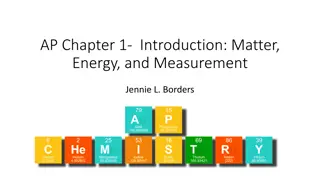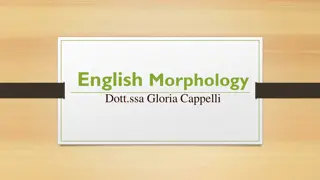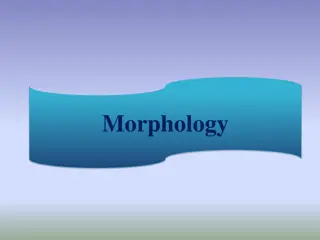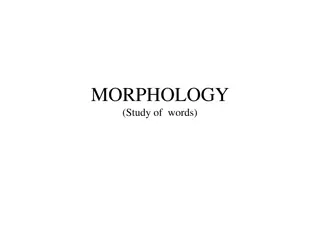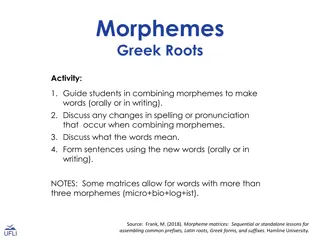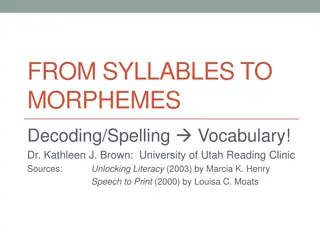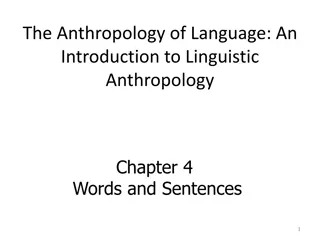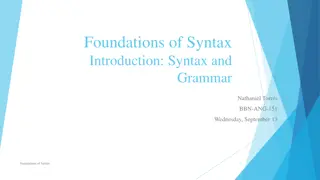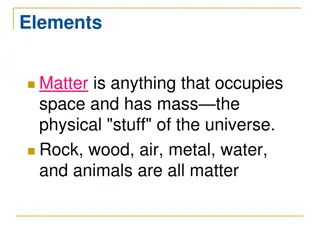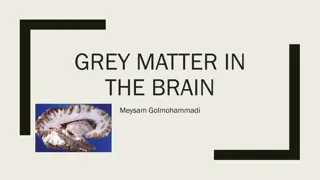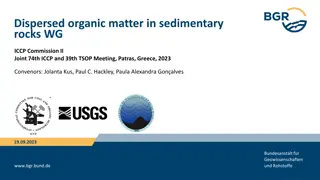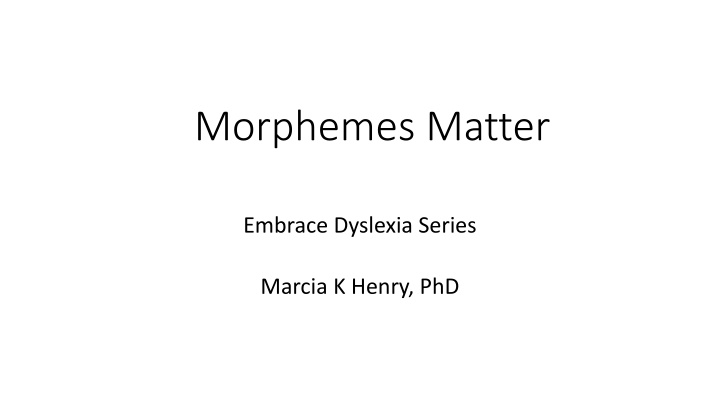
Unpacking the Importance of Morphology in Language Structure
Explore the significance of morphology in language structure through concepts like morphemes, borrowing words from other languages, and the layers of language. Discover how understanding morphology aids in reading, spelling, and decoding in English.
Uploaded on | 2 Views
Download Presentation

Please find below an Image/Link to download the presentation.
The content on the website is provided AS IS for your information and personal use only. It may not be sold, licensed, or shared on other websites without obtaining consent from the author. If you encounter any issues during the download, it is possible that the publisher has removed the file from their server.
You are allowed to download the files provided on this website for personal or commercial use, subject to the condition that they are used lawfully. All files are the property of their respective owners.
The content on the website is provided AS IS for your information and personal use only. It may not be sold, licensed, or shared on other websites without obtaining consent from the author.
E N D
Presentation Transcript
Morphemes Matter Embrace Dyslexia Series Marcia K Henry, PhD
English: A Polyglot The truth is that if borrowing foreign words could destroy a language, English would be dead (borrowed from Old Norse), deceased (from French), defunct (from Latin) and kaput (from German). When it comes to borrowing, English excels (from Latin), surpasses (from French) and eclipses (from Greek) any other tongue, past or present. Claiborne, R. (1983). Our marvelous native tongue: The life and times of the English language. New York: Times Books (p. 4) M. Henry, 2020
Layers of Language GREEK Specialized words, used mostly in science, though some, like photograph, are common Understanding the origins of English is useful in reading and spelling. ROMANCE Technical, sophisticated words used primarily in more formal settings such as literature and textbooks ANGLO-SAXON Common, short, everyday, down-to-earth words used frequently in ordinary situations and found in school primers M. Henry, 1987; After Calfee & Associates, Stanford University M. Henry, 2020
Letter-Sound Correspondences Syllable Patterns Morpheme Patterns Anglo- Saxon Anglo- Saxon Latin Latin Greek Greek Framework for Decoding/Spelling Curriculum and Instruction M. Henry, 2020 M. Henry, 1987, 2010
Morphology: mor .phol . o . gy (m r-f l - j ) n. 2. Linguistics The study of the structure and form of words in language or a language, including inflection, derivation, and the formation of compounds. [G. Morphologie : Gk morph , shape + Gk. logos, word, discussion.] Definition from The American Heritage Dictionary (College Edition, 1982) & The American Heritage Dictionary of the English Language (4th edition 2000).
Morpheme The smallest meaningful unit of language including base words, roots, prefixes & suffixes Anglo-Saxon base words expand by compounding or by affixing (adding prefixes and/or suffixes) Compound 2 base words: railroad bookmark starfish backpack baseball fireplace shoebox butterfly flashlight cowboy skyline birdhouse lamppost bluebird homework schoolroom Affix to base word: help play read spell helper playing reading respell unhelpful replay reread misspell helpfully replayed misread misspelled M. Henry, 2020
Count the morphemes in these words: dogs railroad dog + s (2) rail + road (2) respelled re + spell + ed (3) misunderstanding mis + under + stand + ing (4) M. Henry, 2020
Common Prefixes in- (in or not) inborn, inland, inbred, into un- (not) unlike, untimed, undo, untie mis- (bad, wrong) misgive, misfire, misname dis- (not) disarm, disgrace, dislike, distrust fore- (before) forearm, foreword, forepaw re- (back, again) recall, return, restain de- (down, away from) decode, defog, delight pre- (before) preheat, preview, pretest a- (on, in; to) away, alone, along, aloud CCSS.ELA-Literacy.RF. 2.3d; 3.3a M. Henry, 2020
Common Anglo-Saxon Suffixes -ing, -er, -ed heating - en, -est olden widen oldest biggest heater heated -s, -es -ly, -less, -ness, -ful gladly hopeless -y silky muddy crabby funny cats churches badness painful CCSS.ELA-Literacy.RF.1.3f; 2.3d; 3.3a M. Henry, 2020
Suffixes The following common suffixes are arranged in a suggested order of presentation based on the frequency of use of the suffixes and their adjacent roots. 1 2 er ion (tion, sion) ed most ing ous en or est ess less ure (ture) ness dom ful ent, ence ly an fold ant, ance ship ist hood ive able, ability some y ment 3 ar ible, ibility ize ary ate ward age al ic ity ee fy, ify ty, ity ling 4 ism ious ory cial, cian cious, tious ation tial cy ile ade ium ian M. Henry, 2020
Suffix Addition Rules Once suffixes are taught, students need to learn: When to drop final e when adding a suffix When to double the final consonant when adding a suffix When to change final y to i when adding a suffix M. Henry, 2020
Practice Activities Practice Activities Find base words, suffixes, prefixes in words; Match prefixes with meaning; match suffixes with parts of Speech; Begin dictionary usage; Make word webs; M. Henry, 2020
www.wordworkskingston.com M. Henry, 2020
Web on word wordless Wordlessly wordlessness words worded wording wordage word reword reworded rewording forearm forehead forecast foresee forefathers foreshadow foresight foretell forethought wordy wordily wordiness foreword byword catchword password watchword wordsmith wordplay wordbook wordwork M. Henry, 2003, 2010; Adapted from M.Ramsden www.realspelling.com
Latin Influence So great, in fact, was the penetration of Latin affixing during the Renaissance that it quite undid the Anglo-Saxon habit of compounding as the leading means of word formation in English. From: A Structural History of English (Nist, 1966, p. 11) M. Henry, 2020
Latin & Greek Morphemes Act Differently Anglo-Saxon base words are usually compounded or affixed as a means of word expansion. Latin roots are usually affixed. Ex. extracted, instructor, ambidextrous, reflective Greek roots are usually combined/compounded These roots are often called combining forms. Ex. photograph, phonology, kilometer, hydrosphere M. Henry, 2020
Find the Morphemes in These Words Word Prefix(es) Root Suffix(es) reflection disrupted literature collective subtracting prescriptions reconstructionist _______ pendant submission inspector _______ _______ _______ _______ _______ _______ _______ _______ _______ _______ _______ _______ _______ _______ _______ _______ _______ _______ _______ _______ _______ _______ _______ _______ _______ _______ _______ _______ _______ M. Henry, 2020
Activities Related to Latin Morphemes Circle the Latin word roots in the following words: nondescript conference Matching: Match the Latin root with the letter of the correct meaning: _____ rupt A. to say or tell _____ spect B. to breathe _____ dict C. to break or burst _____ flect D. to pull _____ spire E. to bent _____ tract F. to see transference attractive convertible adversary Write the Latin root that means: to pull _____________ to build ___________ to write _____________ to bend ___________ to see _____________ to break ___________ to hear _____________ to run __________ M. Henry, 2020
Activities for Latin Morphemes - 2 Fill in the blanks with the best word from the following choices: interrupted information convertible spectators My _________ card had mostly A s. My sister __________ our telephone chatter. The building was ____________ by heavy beams. Give me new _____________ on the research. I have a new yellow _______________. 1. 2. 3. 4. 5. formality supported report formula Circle a word with a Latin root to replace the underlined word(s). My teacher helped the principal at lunchtime. informer Turn in your research paper tomorrow. manuscript instructor reporter prescription protractor Discussion on word pairs: Compare the behavior of an extrovert and an introvert. How do intrastate and interstate highways differ? M. Henry, 2020
Web on struct in- instruct instructs instructed instructing instruction instructional instructor instructive instructively con- construct constructs constructing constructed constructions constructive constructively struct to build structure structures structured structuring structural structurally restructure restructured substructure superstructure infrastructure reconstructionists de- ob- destructive destructively destruction destructible destructibility destruct obstruct obstructs obstructing obstructed obstruction obstructive M. Henry, 2020
bankrupt bankruptcy bankruptcies interrupt interrupts interrupting interrupted interruption interruptions abrupt abruptly abruptness rupture ruptured ruptures rupturing uninterrupted uninterruptedly rupt corrupt corrupts corrupted corruptly corrupting corruptible corruptive corruptiveness corruptively corruptivity corruption to break or burst disrupt disrupts disrupting disrupted disruption disruptive disruptively disruptiveness erupt erupts erupted erupting eruption eruptions incorruptible incorruptibility
Greek Influence Suppose you could examine a green part of a plant under the microscope. What would you see? Here are some cells from the green part of a plant. The cells have small green bodies shaped like footballs. They give the plant its green color. They are called chloroplasts. Chloroplasts are very important to a plant. As you know, plants make their own food. This food- making process is called photosynthesis. It is in these chloroplasts that photosynthesis takes place. M. Henry, 2020
Greek Combining Forms Order of Presentation phon/phono tele therm biblio polis hypo phys path poly cogn mech the/theo ast(astro) photo ology bio crat/cracy dem hyper psych peri mon/mono meta kine/cine andr/anthr archae/arche graph/gram micro scope geo derm chron techni hemi/semi/demi gon mega phil phobia auto meter hydro metro cycl chrom lex sphere arch soph mania M. Henry, 2020
Count the morphemes in these words: auto + bio + graph + y (4) autobiography bibliophile biblio + phile (2) photo + sys + thesis (3) photosynthesis M. Henry, 2020
Identify the Language of Origin philharmonic ___ psychology___ extraction ___ hopelessness ___ introspective ___ laughing ___ bookish ___ manufactured ___ expeditious ___ hydrophobia ___ auditor ___ astrophysics ___ M. Henry, 2020
Activities Related to Greek Combining Forms Nym and onym are the Greek roots meaning name. Find as many words as possible ending in onym. Give examples of pseudonyms, antonyms, synonyms, and homonyms. Select unfamiliar words & ask questions related to word origin, clues, meaning, definition, etc. Ex. Analyze the word pterodactyl. What is its origin? What are the two combining forms? What is the meaning of ptero and dactyl? In what subject areas might you find this word? Make a web for a Greek combining form such as phon/phono. Give students a sentence with an unknown word such as Heterographs abound in the English language . Students study word using a dictionary & thesaurus to find its origin, meaning, and synonyms. Have them look for additional examples such as inquiry/enquiry, catalog/catalogue). M. Henry, 2020
Greek Word Activities - 2 Matching: Match the letter of the correct meaning with the Greek Combining Form: _______ micro A. sound _______ ology B. life _______ auto C. watch or see _______ graph, gram D. self _______ therm E. distant _______ tele F. small _______ bio G. study _______ phon, phono H. water _______ scope I. heat _______ hydro J. written or drawn M. Henry, 2020
Greek Activities 3 Have students categorize words in a textbook chapter according to origin. Prehistoric Times Anglo-Saxon earthquake embedded hunter spearhead imprint fossil Latin ancestors evolution extinct aggregate volcano prehistoric Greek tectonics anthropologist geologist archaeology pterodactyl metamorphic M. Henry, 2020
Morpheme Morpheme smallest meaningful unit of language smallest meaningful unit of language Count the morphemes & syllables in these words: photograph autobiography hemisphere dermatologist pathophysiology M. Henry, 2020
Identify the Language of Origin philharmonic ___ psychology___ extraction ___ hopelessness ___ introspective ___ laughing ___ bookish ___ manufactured ___ expeditious ___ hydrophobia ___ auditor ___ astrophysics ___ M. Henry, 2020
Activities May be Found in: Henry, M. K. (2010). Unlocking literacy: Effective decoding and spelling instruction. (2nd ed.). Baltimore: Paul S. Brookes Publishing. Henry, M.K. (2010). WORDS. (2nd ed.). Austin, TX: Pro-Ed. Henry, M.K. & Redding, N.C. (2004). Patterns for success in reading and spelling; Activity books, Parts 1, 2, & 3. Austin, TX: Pro-Ed. M. Henry, 2020

